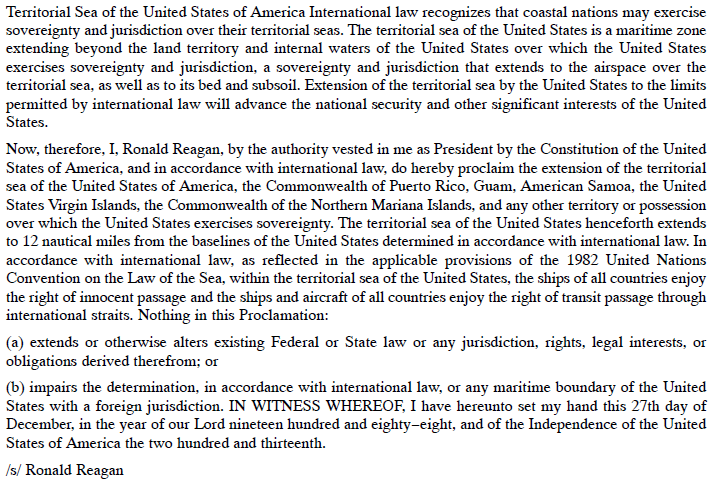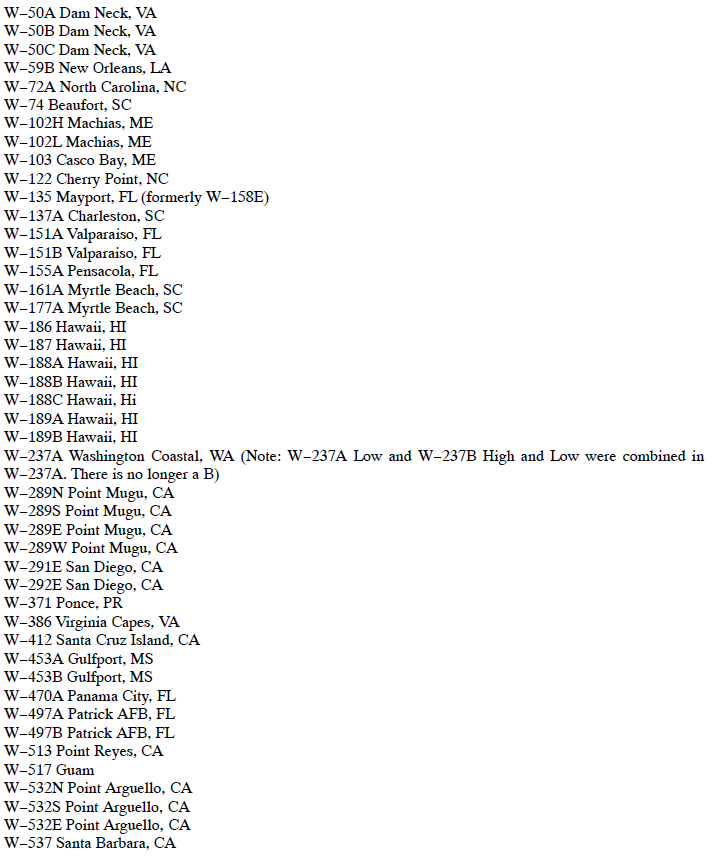Section 1. General
- Warning areas were originally established only over international waters, beyond the U.S. territorial limit. Until 1988, U.S. territorial waters extended out to 3 NM from the shoreline. On December 27, 1988, President Ronald Reagan signed Presidential Proclamation No. 5928 that extended the territorial sea of the U.S. outward to 12 NM from the shoreline. In order to expand the U.S. domestic air traffic control authority to cover the newly designated domestic airspace, the FAA issued a final rule that extended controlled airspace, and the applicability of 14 CFR parts 71 and 91, to the airspace overlying the waters between 3 and 12 NM from the U.S. shoreline.
- At that time, most warning areas extended outward from 3 NM from the shoreline. Because the Proclamation converted the airspace between 3 and 12 NM from international to domestic airspace, this jeopardized the status of the existing warning areas inside the new 12 NM limit. Additionally, the extension of part 91 operating rules to this airspace would have required DoD to either request exemptions to the CFR to continue conducting hazardous activities in the airspace between 3 to 12 NM or those warning area segments inside 12 NM would have to be redesignated as restricted areas under 14 CFR part 73. However, if those segments were redesignated, nonparticipating aircraft (such as fish spotters, exploration, offshore oil platform support flights, etc.) would be excluded from airspace where they had safely operated for decades. This would result in adverse impact on those operators.
- Accordingly, the FAA issued Special Federal Aviation Regulation (SFAR) No. 53 that established “warning areas” overlying the waters between 3 and 12 NM from the shoreline, and defined “non-regulatory warning areas” as those areas beyond 12 NM over international waters. The SFAR permitted the continuation of military training activities in the warning areas overlying the waters between 3 and 12 NM. The SFAR was made effective for a period of one year to provide time for the FAA to consider the need for additional action to meet military training requirements without creating an unacceptable impact on either DoD or civilian flight operations overlying the waters inside 12 NM. The SFAR was subsequently extended three times. The warning areas established by the SFAR were unique airspace designations intended solely to allow the continuation of military training activity and maintain the right of nonparticipating aircraft to fly through such areas.
- The FAA and the DoD worked for several years to move the inner boundaries of pre-existing warning areas outward to 12 NM. However, DoD determined that the boundaries of selected warning areas could not be moved because of the need for continued connectivity to existing range resources (e.g., DoD missile launches).
- In 1996, the FAA resolved the issue by creating a new warning area definition that combined the SFAR definitions of “warning area” and “non-regulatory warning area.” This allowed selected warning areas to remain over domestic waters. The FAA codified the new warning area definition by adding it to 14 CFR §1.1, General Definitions. The new definition applies equally to those warning area segments within domestic airspace (from 3 to 12 NM from the shoreline), and to those in international airspace (beyond 12 NM from the shoreline). In effect, the new definition grandfathered a select number of warning areas to remain within domestic airspace between 3 and 12 NM of the shoreline. But, the rule also stated that any new SUA requirements overlying the waters within 3 to 12 NM from the shoreline would have to be the appropriate domestic type of SUA (e.g., restricted areas or MOAs).
REFERENCE-
Presidential Proclamation No. 5928 (54 FR 777; December 27, 1988) (See Fig 24-1-1).Final Rule - Applicability of Federal Aviation Regulations in the Airspace Overlying the Waters Between 3 and 12 Nautical Miles for the United States Coast (54 FR 264; January 4, 1989).Special Federal Aviation Regulation No. 53 - Establishment of Warning areas in the Airspace Overlying the Waters Between 3 and 12 Nautical Miles from the United States Coast (54 FR 260; January 4, 1989).
Final Rule - Definitions of Special Use Airspace (61 FR 2080; January 24, 1996).
A warning area is airspace of defined dimensions, extending from 3 nautical miles outward from the coast of the United States that contains activity that may be hazardous to nonparticipating aircraft. The purpose of such warning areas is to warn nonparticipating pilots of the potential danger. A warning area may be located over domestic or international waters or both. (14 CFR section 1.1, General Definitions)
NOTE-
Only those pre-existing grandfathered warning areas listed in fig. FIG 24-1-2 extend over domestic waters between 3 NM and 12 NM from the shoreline. All other warning areas extend over international waters from 12 NM outward from the shoreline.
Based on the provisions of Presidential Proclamation No. 5928 (See Fig 24-1-1), historical SFAR No. 53 (54 FR 260; January 4, 1989), and the Definitions of Special Use Airspace final rule (61 FR 2080; January 24. 1996), the following policies apply:
- Forty-five existing warning areas were “grandfathered” permitting them to retain the segments overlying the domestic waters between 3 and 12 NM from the U.S. shoreline. The military training activities, non-participant aerial access, and operating procedures in the grandfathered warning areas are the same as those in the warning areas extending beyond 12 NM outward from the shoreline. No new operating restrictions were imposed on the grandfathered warning areas. (See FIG 24-1-2).
- No new warning areas may be established in, or existing warning areas expanded into, domestic airspace overlying the waters between 3 and 12 NM from the shoreline. For new requirements that arise for SUA within 12 NM from the shoreline, the appropriate type of domestic SUA, (i.e., prohibited area, restricted area or MOA) must be designated or established.
- Participating aircraft. Participating pilots conducting aircraft operations within a grandfathered warning area segment, (i.e., between 3 and 12 NM from the shoreline) and operating with the approval of the using agency, may deviate from the rules of Part 91, sub part B, to the extent that the rules are not compatible with approved operations.
- Nonparticipating aircraft. Nonparticipating VFR pilots, while not excluded from warning areas, are on notice that military activity, which may be hazardous to nonparticipating aircraft, is conducted in those areas.
Identify warning areas with the letter “W" prefix followed by a dash; a two- or three-digit number; a location; and the two-letter state abbreviation (e.g., W-291, San Diego, CA). Warning area subdivisions may be identified by a suffix consisting of a letter, a cardinal point, the terms “High” or “Low”, or a combination (e.g., W-105A; W-220A High; W-13A Low). The Airspace Rules and Regulations Team, AJV-P21, assigns identification numbers.
Warning areas must be considered for joint-use if the area, or portions thereof, can be returned to the controlling agency during periods when it is not required for its designated purpose, and provided the warning area is located in airspace wherein the FAA exercises ATC authority under ICAO agreements. When designating a warning area for joint-use, a letter of agreement must be executed between the controlling and using agencies to define the conditions and procedures under which the controlling agency may authorize nonparticipating IFR aircraft to transit or operate within the area. Apply the provisions of paragraph 23-1-5, Joint-Use, as appropriate.
FIG 24-1-1
Presidential Proclamation No. 5928 December 27, 1988, (54 F.R. 777)

